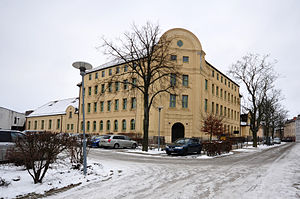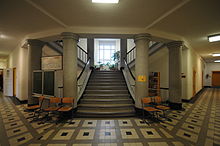Einstein-Gymnasium Angermünde
| Einstein-Gymnasium Angermünde | |
|---|---|

|
|
| type of school |
Gymnasium (grades 7-12) |
| founding | 1901 |
| address |
Heinrichstrasse 7 |
| place | Angermünde |
| country | Brandenburg |
| Country | Germany |
| Coordinates | 53 ° 1 '7 " N , 13 ° 59' 52" E |
| carrier | Uckermark district |
| student | 409 As of 2020 |
| Teachers | 35 As of 2020 |
| management | Kerstin Hainich-Doepner |
| Website | www.einsteingym.de |
The Einstein-Gymnasium Angermünde is a high school in Angermünde , which is sponsored by the district of Uckermark in Brandenburg .
Naming
Besides the Albert-Einstein-Gymnasium in Berlin-Britz , the Einstein-Gymnasium Angermünde is the only one that received personal permission from Albert Einstein to use his name. On April 14, 1950, Einstein gave his approval by letter from the USA and at the same time thanked him for the honor he had been shown.
history
Private school
In 1881, Oskar Knuth opened a private school with the support of the magistrate, which included a pre-school class and classes 4, 5 and 6, the latter being taught according to the grammar school curriculum. In Knuth's school, which also included a boarding school, 108 students learned who paid a tuition fee of 150 marks.
Up until 1884 Knuth was exposed to attacks from the middle school, the number of pupils falling steadily because the private school was preferred. Disappointed with the government, Knuth announced the closure of the private school at Easter 1884. This decision was a blow to the parents who reacted to the situation in August 1884 with a "Society for the Maintenance and Upgrading of the Higher School for Boys in Angermünde". The efforts were unsuccessful in the long run.
Municipal high school for boys
This school was founded in 1901 as a secondary school with secondary Latin courses. It was headed by Director Dammholz until 1914.
At the same time the struggle for recognition as a higher education institution began. In 1912 the municipal authorities applied for the institution to be subordinated to the Royal Provincial School Board and the school to be recognized as a Realprogymnasium.
At the end of the year, the mayor declared the municipal high school for boys to be closed after it had been in existence for 13 years.
Uckermärkische Oberschule for boys
On April 15, 1914, the Realprogymnasium was opened with the introduction of the new teaching staff. The life of the new school was marred by four years of war, famine, inflation, economic collapse and the November revolt.
After the First World War, there was a desire to be able to take the Abitur in Angermünde.
The UI was established at Easter 1920 and the OI at Easter 1921. In autumn 1916, due to the consequences of the First World War, due to a lack of labor and difficulties in obtaining materials , the school moved late to the bright and spacious building on Heinrichstrasse - today's schoolhouse. The supervisory authority rated it as exemplary for the small town of Angermünde. Girls were allowed to attend school for the first time in 1922. The good reputation of the school led to an increase in the number of students with a high of 245 high school students in 1931.
The school reform in 1938 created a uniform higher school - the Oberschule. The Realgymnasium was renamed Die Uckermärkische Oberschule for boys . At the same time, the secondary school for girls was established in what is now the Zetkin School.
From the unified school to the Einstein high school
After the end of the war in 1945, in accordance with the law on democratic school reform, the Uckermärkische Oberschule for boys was converted into a single school. In search of a name, after extensive discussions, it was decided to ask Albert Einstein to give the school his name. Einstein followed this request in a letter dated April 14, 1950.
In these years the idea of the boarding school was taken up again. By 1957 the number of boarding school students grew from 40 to 101. In the course of the school reform of 1960, the ten-class general education polytechnic high school (POS) and the extended high school (EOS) were created.
After the turnaround and the school reform, the EOS became the Einstein-Gymnasium at the beginning of the 1990/1991 school year. Since then, students have been admitted to the seventh grade. The Abitur can be taken after seven years. In 1994 the school began to expand. At the same time, the building was given a multi-purpose hall with a direct connection to both parts of the school building; the old sports hall was converted into an auditorium.
Well-known graduates
- Jochen von Arnim (1925–2015), local history researcher
- Walter Bredendiek (1926–1984), Protestant theologian and local history researcher
Partner schools
Web links
- Entry in the monument database of the State of Brandenburg
- Website of the Einstein-Gymnasium
- Annual report: about the school year ... Realprogymnasium i. E. Angermünde. Angermünde, 1915 ( digitized version )



